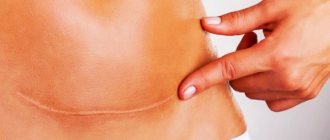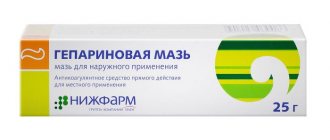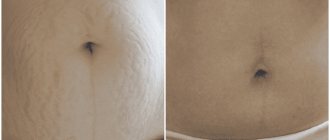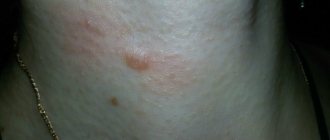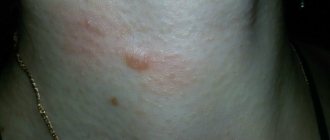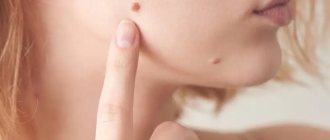Scars and scars - what are they?
Not only ladies suffer from scars on their skin. If a defect forms on the face, it can greatly spoil a person’s appearance. The most common type of scars is from acne, especially those that were roughly squeezed out. Post-acne scars require mandatory cosmetic care, otherwise they can remain for life.
Other common types of scars are:
- Traces of chickenpox
. It happens not only in children - when the disease develops in adulthood, the papules are very large, deep, and traces of them are very noticeable. - Cuts and burns
. Most often they appear on the hands, and over time they become lighter than other skin. - Scars after surgery, serious injury
. They can occupy a large area and persist forever. - Stretch marks
. They appear after rapid intensive weight loss, after childbirth in women - on the chest, abdomen, hips.
There are several types of scars. Keloids are characteristic of post-operative, post-traumatic scars - they rise above the surface of the skin and tend to grow in the future. Hypertrophic scars are also higher than the normal level of the skin, but do not exceed the area of the original lesion. Atrophic scars are inherent in old marks from carbuncles, boils, and pimples, representing “depressions” in the skin.
How to remove scars after surgery: modern cosmetic procedures
If there is a large scar left on the body after surgery, it is better to remove it using cosmetic procedures. Modern methods are safe and effective. There are several options for eliminating scars after surgery:
- Filling with collagen. A method recommended only for atrophic scars. It involves filling the depression with collagen and leveling the surface. The effect lasts for 12 months.
- Cryodestruction. The method involves treating the scar with liquid nitrogen. Damaged tissue is frozen and destroyed, and healthy skin grows in its place. The disadvantage of the method is pain, requiring anesthesia.
- Microwave therapy. The epidermis is exposed to electromagnetic waves, which allows you to achieve lasting results. In some cases, additional cryodestruction is required.
- Microdermabrasion. The surface of the epidermis is polished using chemical compounds - acids, powdered aluminum oxide. The downside is the ability to work only with small superficial scars.
- Dermabrasion. Another grinding option involves the use of special brushes. When carried out correctly, the procedure is safe, but violation of the technique can lead to the formation of new scars.
- Bukki-irradiation. The skin is treated with ultra-soft x-rays, which initiate the reverse development of the scar. The method is used for keloid and hypertrophic scars, but is prohibited in case of circulatory problems.
- Laser irradiation. The most common method recommended by doctors who tell how to get rid of scars after surgery. The method is suitable for different types of skin changes. Laser scar resurfacing is a quick procedure that is performed under local anesthesia.
Surgical intervention
In rare cases, when a scar causes significant discomfort, and a course of laser scar removal after surgery did not help, plastic surgery methods are resorted to. During the manipulation, the doctor excises the damaged tissue and transplants a skin flap of the patient taken from another area. The entire process takes about an hour and is performed under general anesthesia. Next begins the rehabilitation period, which may take several months.
Types of ointments for scars
A large number of ointments, gels, and creams are produced to treat various skin problems. The most effective ointment is the one that suits the indications and contains the necessary active substances. It is more convenient to use ointments in tubes rather than in jars, which is why they are more popular.
The doctor may recommend different remedies:
- Preparations with regenerating and antiseptic effects. They are used in the stage of active inflammation to prevent the appearance of scars. If you start applying the ointment immediately, purulent processes will not occur, the skin will stop inflaming, and the pain will go away.
- Products with a rapid healing effect, anti-inflammatory ointments. Recommended at the earliest stages of skin scarring. In tissues, after using the drugs, the production of collagen and elastin increases, which prevents connective tissue from growing.
- Medicines with absorbable components. They are great for removing or reducing old scars on the skin.
Creams and ointments act at the local level and almost do not enter the systemic bloodstream, so they can be used for a long time.
Ointments from the second group are also called keratolytics; their purpose is to prevent the appearance of scars. Drugs from the third group are fibrinolytics, their task is to treat scars on the skin.
[media=
https://youtu.be/2QN1lAjcc0c
]
Indications for use of creams
The main indications for treatment with such drugs are specified in the instructions for use. In addition to preventing the appearance of scars after injuries, burns, operations, ointments are indicated against:
- atrophic post-acne scars, boils, ulcers;
- scars from mechanical damage, chemical burns;
- scars from chickenpox and other skin diseases;
- stretch marks on the skin;
- hypertrophic scars;
- keloid scars;
- tendon contractures after operations, injuries;
- ankylosis with limited joint activity;
- Dupuytren's contracture.
If you apply creams to the skin daily, they normalize blood microcirculation in the affected area and stop the growth of connective tissue onto the healthy epidermis. Thanks to penetration into the deepest layers of the skin, cells begin to regenerate from the inside, and it also ensures that the right amount of moisture is retained and the skin is sufficiently hydrated. All effects together prevent the proliferation of keloid fibroblasts and stimulate skin regeneration. Typically, all products are applied to clean skin up to 3 times a day - according to the instructions.
Contraindications and side effects
Despite the safety, each product has its own prohibitions on use. They depend on the components that are included in the composition. General contraindications for all ointments are usually:
- intolerance, allergic reactions;
- open wound in the scar area;
- severe purulent phenomena;
- ulcers, areas of necrosis on the skin;
- skin diseases with an acute course in the scar area;
- oncological or precancerous tumors in the area where the ointment is applied;
- a scar on the mucous membrane, in the eye area (medical assistance is required for treatment).
Some drugs indicate that they cannot be used during pregnancy, lactation, or in children under 1-3 years of age, but due to the minimal systemic effect, such restrictions are rarely strict.
You cannot use drugs one after another without a certain period of time - this can lead to allergic reactions and increase side effects.
Usually, ointments for scars are well tolerated, but sometimes side effects occur. These are abnormal local reactions: rash, itching, burning, feeling of skin tightness, redness, hyperthermia. Typically, “side effects” mean the development of allergic reactions; if severe, they require discontinuation of the drug.
Contraindications
These products should not be used in the following situations:
- in case of individual intolerance to ingredients;
- for treating partially healed, inflamed or festering wounds;
- in case of a tumor at the site of drug exposure;
- in close proximity of the scar to the mucous membranes.
Preparations that resolve scars have virtually no negative effects on the body, since they are used only externally. In case of high sensitivity, there may be adverse reactions in the form of skin rashes, redness or itching. Therefore, before applying the cream to the scar site, it is recommended to do a sensitivity test.
Contractubex is the most popular ointment
The drug Contractubex is prescribed by specialists more often than other drugs due to its powerful absorbable effect. The product costs about 600 rubles for 20 ml, this volume is quite enough to treat small scars. The gel contains sodium heparin, onion extract, allantoin.
The anti-inflammatory and fibrinolytic effect of the drug is ensured by the presence of onion extract, the keratolytic effect is provided by allantoin, and heparin has an antithrombotic effect. The drug has the following effects on the skin:
- stimulation of cellular regeneration;
- dissolution of the keratinized layer of scar cells;
- increasing the rate of formation of young cells;
- improvement of blood microcirculation;
- softening tough scar tissue and improving water balance;
- decrease in the rate of formation of fibroblasts - connective tissue cells of the scar;
- reduction of foci of inflammation.
Effective Contractubex ointment is applied to the skin in the area of a fresh scar, and is also used to prevent the formation of scars. It is enough to use it 2-3 times a day for a course of 4 weeks.
Before going to bed, it is better to apply the gel under a bandage made of gauze or a cotton cloth - the treatment results will be better.
If there is an old defect on the skin, it will have to be treated with Contractubex for up to 3-6 months.
[media=
https://youtu.be/KVe_7yZccmU
?t=7s]
Prevention
Whether a mark remains after damage or surgery or not depends on the individual characteristics of the patient’s body. And with surgical intervention - on its volume and severity. Prevention in any case should be aimed at preventing the formation of keloids. In particular, today doctors are trying to perform minimally invasive, including endoscopic, operations that minimize the risk of defect formation. There are also a number of drugs prescribed by a doctor immediately after epithelization of the wound. Their correct and timely use helps to avoid the formation of a rough mark.
We recommend
Curacen Essence (20 fl x 2 ml)
Laennec – solution for injection
Bb Laboratories – Serum “Arcanum”
Premium set “Ideal facial skin. Healthy tone"
Inexpensive ointments for scars
The best anti-scar ointment is not necessarily the most expensive product. You can buy medications from this group inexpensively, but the effect will be excellent. Below are the main ointments from the economy segment that are sold in every pharmacy.
| Name | Action | Course of therapy | price, rub. |
| Ichthyol ointment | Antiseptic, absorbable | 3-8 weeks | 70 |
| Vishnevsky ointment | Antiseptic, activating blood microcirculation | 3-12 weeks | 75 |
| Heparin ointment | Regenerating, increasing skin elasticity | 1-3 months | 75 |
| Epitonex | Absorbing, accelerating skin healing, whitening | 2-3 months | 250 |
| Methyluracil | Stimulating tissue regeneration | 1.5-3 months | 95 |
Adherents of natural medicine prefer to use herbal creams. For example, the drug Elastik contains various oils and extracts that help the skin get rid of defects and restore an even structure.
Other remedies for skin scars
Among the drugs against skin defects, the doctor may recommend Zeraderm, Zeraderm Ultra (900-1200 rubles). They promote rapid resorption of scars by creating a film of polysilicone. Under the film, the skin is moisturized, quickly softens, and connective tissue cords are absorbed. All inflammatory changes and discomfort are also eliminated. The drug is prescribed even to children and pregnant women.
Other popular ointments are:
- Dermatix, Dermatix Ultra
(about 2200 rub.). Contains polysilicone, inorganic silicon oxide. The drug reduces the scar, while simultaneously lightening it. - Kelo-cote
(1600 rub.). The composition is similar to that described above, the drug is intended to restore elasticity to the skin and reabsorb scar tissue. - Mederma
(1300 rub.). Contains Serae onion extract and allantoin. The drug is indicated against all types of scars, but mainly “young” ones - up to a year old.
You can also find Kelofibraza-cream, Fermenkol, Regivasil, Sledotsit, Klirvin, Spasatel on sale. Regular use of creams will make the scar less noticeable, so it is better to start using them immediately after the defect appears.
Chemical peeling
Peeling is the destruction of scar tissue due to the action of various organic acids. They also help optimize fat metabolism, which can also help get rid of acne. There are several types of chemical peeling (depending on the reagent used):
- TCA peeling (using 3-chloroacetic acid with a concentration of 35-50%).
- Retinoic (based on retinoic acid, which not only destroys scars, but also has an antibacterial effect).
- Phenolic (phenol-based - it also helps get rid of scars and destroys bacteria). However, phenol is toxic and can have a bad effect on the nervous system.
Chemical peeling is contraindicated in the following cases:
- recurrence of acne;
- tendency to keloid scars;
- wounds, neoplasms;
- individual intolerance to the substances used.
